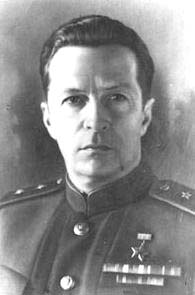 |
General Mikhail Mikhailovich Gromov |
Who was "Egorov?"
Who was the mysterious General who encountered the Russell group? Was he who he claimed to be?
While there had been several Soviet record-breaking flights to the US in the 1920s and '30s, only two had flown nonstop over the North Pole, and only one had landed in Washington State.
On June 20, 1937, Valeri Chkalov, Georgiy Baidukov and Alexander Belyakov landed their huge Tupolev ANT-25 distance-record plane, named "Route of Stalin," at Pearson Field, Vancouver, Washington, after an incredible 63 hour flight from Moscow which established a world's distance record. However, Chkalov, an experienced polar pilot, was killed in a crash in 1938, ruling him out as Russell's contact.
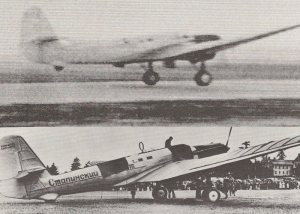 |
Chkalov's ANT-25, Route of Stalin, Top, Moscow takeoff, June 18, 1937. Bottom, Vancouver, Washington, after the transpolar flight. Images from Russia’s Shortcut to Fame. |
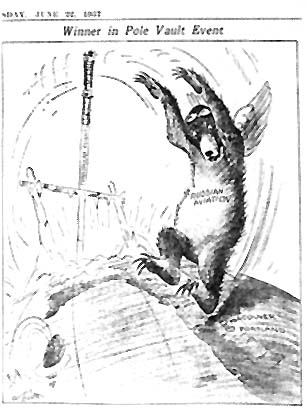 |
Cartoon from June 22, 1937 edition of Portland Oregonian, shows Russian bear vaulting over North Pole to Washington State |
The second USSR-US nonstop polar flight of the 1930s was commanded by Mikhail Gromov.
Was "Egorov" (or more properly, "Yegorov") in fact General Mikhail Mikhailovitch Gromov? It is difficult to compare the legendary Gromov, one of the greatest pilots in the annals of Soviet aviation, to a single American counterpart. He would be something like a combination of Charles Lindbergh and Chuck Yeager. The FRI, the Russian equivalent of NASA's Dryden test center at Edwards Air Force Base, is named for Gromov.
Along with Sergei Danilin and Andrei Yumashev, Gromov made the second epic polar flight, this time spanning over 6,300 miles from Moscow to San Jacinto, California, between July 12 and 14, 1937.
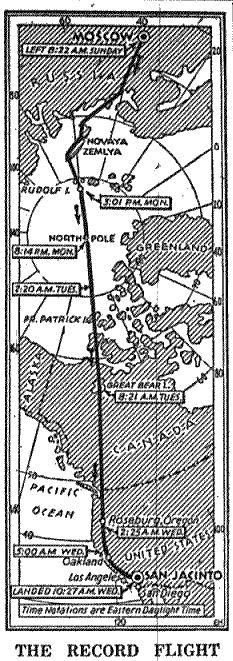 |
New York Times, July 15, 1937 |
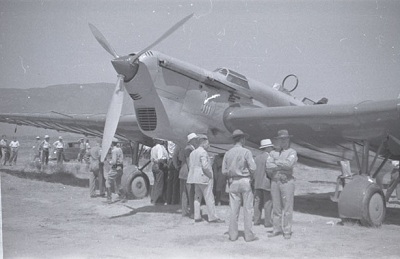 |
Gromov's ANT-25 in San Jacinto, California, July 14, 1937 |
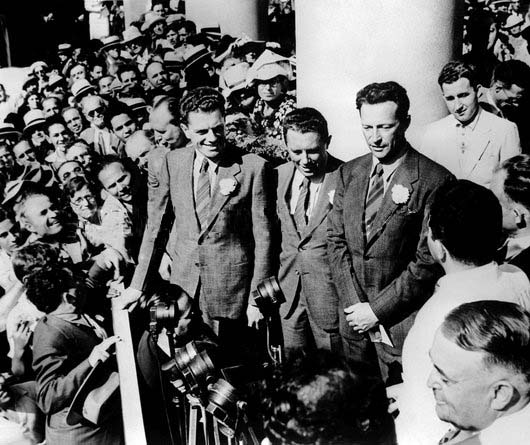 |
Danilin, Gromov and Yumashev receive heroes' welcome, New York City, July 1937 |
Gromov was born in 1899, which fits with the Russell party estimate that "Egorov" was about 55 years old. According to East German sources, Gromov actually did retire in 1955. The reference to a flight to "Washington State" could be an error on Efron's part.
Gromov was in fact a Hero of the Soviet Union, as "Egorov" claimed to have been, and had been appointed Deputy Commander in Chief of the Soviet Long-Range Air Force in 1946. Both Gromov and Chkalov had met with Democratic President Franklin D. Roosevelt during ceremonies celebrating their achievements. The Soviets certainly could have exploited Russell's knowledge of these meetings.
But there is more to the Gromov story.
From June 1934 to May 1935, he had been chief pilot of the Maksim Gorkii Agiteskadril ("Maxim Gorky Propaganda Squadron"). The flagship of this unit was the mammoth Tupolev ANT-20, an eight-engined colossal flying propaganda bureau, a Stalin-era creation straight out of Orwell.
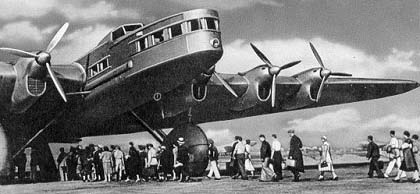 |
ANT-20 number 2 |
Possibly the first airplane specifically designed as a government propaganda tool, and certainly one of the largest airplanes in the world at the time, the ANT-20 (wingspan 207 feet, length 108 ft) carried a crew of eight plus 72 passengers. In addition, the Maksim Gorkii was equipped with a film projection room, a photo lab, a 16-line telephone exchange, four radio transmitters, a printing press, a pneumatic tube mail distribution system, propaganda leaflet dispensers, loudspeakers to blare speeches and recordings to persons on the ground, and an incandescent light-matrix under the wings capable of displaying animated Stalinist slogans!
So Gromov had been intimately tied to high-profile state propaganda aviation projects over a long period. Moreover, he had been used as a contact with prominent Americans in the USSR. After his 1937 record flight to California, Gromov and his crew were entertained for a week in New York City by Eddie Rickenbacker, World War I ace and General Manager of Eastern Air Lines. In July 1943, Rickenbacker, acting as a representative for the Army Air Force, flew to Moscow to negotiate a Lend-Lease arms deal. During his visit he was given a tour of the Ilyushin Sturmovik ground attack fighter plant, where he reencountered Gromov, who was introduced as the factory's chief test pilot. Gromov took Rickenbacker on a demonstration flight which included live gun and rocket fire. Gromov was actually the head of the Flight Research Institute in 1940-41 and at the time of Rickenbacker's visit was an active combat commander on the Western Front.
According to Gromov's Russian biography, in the post-WWII period he was personally involved in flight testing of the Tupolev Tu-70, a Soviet derivative of the US B-29 bomber.
If the Soviets ever actually had been conducting secret penetration overflights in US skies, as some Air Intelligence analysts feared, in all probability Gromov would have been involved in some manner. He is the exact person who would have been expected to have headed such a project.
But how likely is it that a figure of epic proportions like Gromov would have just happened to be on the train with Russell? The chances seem very remote, and one explanation seems to be that the individual was not Gromov and was merely teasing the Americans. In any case, the Americans seem to have believed he was Gromov, and Russell continued to refer to the Polar flights in speeches years later. The mere possibility was provocative in the extreme and is one of the most intriguing aspects of the Russell incident.
Sources
Baidukov, Georgiy, Russian Lindbergh:The Life of Valery Chkalov (Washington, DC: Smithsonian Institution Press, 1991)
Boyd, Alexander, The Soviet Air Force Since 1918 (New York: Stein and Day, 1977)
Gunston, Bill, Encyclopedia of Russian Aircraft, 1875-1995 (Osceola, WI: Motorbooks International, 1995)
Machatsaheck, Heinz, "Episoden aus der Geschichte der sowjetischen Luftfahrt," Flieger-Jahrbuch 1979 (Berlin: transpress VEB Verlag für Verkehrswesen, 1978)
Morrison, Robert J., Russia's Shortcut to Fame, (Vancouver, WA: Morrison & Family Publishing House, 1987)
Rickenbacker, Edward V., Rickenbacker: An Autobiography (Englewood Cliffs, NJ: Prentice-Hall, 1967). Robert Gros also knew Rickenbacker. At a January 1999 document auction at the Pacific Book Auction Galleries the following items were inventoried for sale: Rickenbacker, Eddie V. Lot of two items signed as President of Eastern Airlines. 1. Typed Letter Signed in full on color-imprinted Eastern Air Lines stationery,two pages, quarto, New York, 8 September 1943. To Robert Gros regretting that his Report to the American People is being perceived as a reversal of Rickenbacker's previous anti-Russian declarations...I am against Communism... Very good condition. 2. Typed Letter Signed in full on color-imprinted Eastern Air Lines stationery, one page, quarto, New York, 24 may 1944. To Robert Gros writing that he will be happy to see him, File notes in lower margin, else fine.
New York Times, July 11-16, 1937